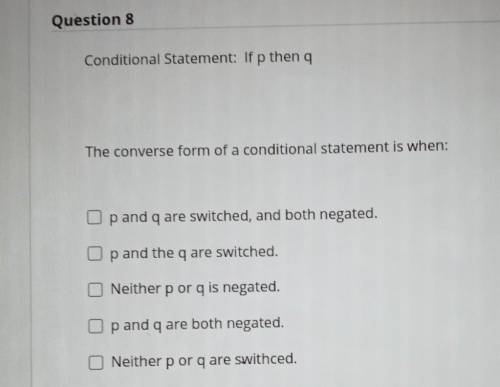
Mathematics, 05.07.2021 23:50 leeshaaa17
Conditional Statement: if p then q The converse form of a conditional statement is when: O p and q are switched, and both negated. p and the q are switched. Neither p or q is negated. O p and q are both negated. Neither p or q are swithced.


Answers: 2


Another question on Mathematics

Mathematics, 21.06.2019 19:00
Billy plotted −3 4 and −1 4 on a number line to determine that −3 4 is smaller than −1 4 is he correct? explain why or why not?
Answers: 3

Mathematics, 21.06.2019 20:40
David estimated he had about 20 fish in his pond. a year later, there were about 1.5 times as many fish. the year after that, the number of fish increased by a factor of 1.5 again. the number of fish is modeled by f(x)=20(1.5)^x. create a question you could ask that could be answered only by graphing or using a logarithm.
Answers: 1

Mathematics, 21.06.2019 22:50
He graph of f(x) = |x| is stretched by a factor of 0.3 and translated down 4 units. which statement about the domain and range of each function is correct? the range of the transformed function and the parent function are both all real numbers greater than or equal to 4. the domain of the transformed function is all real numbers and is, therefore, different from that of the parent function. the range of the transformed function is all real numbers greater than or equal to 0 and is, therefore, different from that of the parent function. the domain of the transformed function and the parent function are both all real numbers.
Answers: 3

Mathematics, 21.06.2019 23:00
The equation shown below represents function f. f(x)= -2x+5 the graph shown below represents function g. which of the following statements is true? a. over the interval [2, 4], the average rate of change of f is the same as the average rate of change of g. the y-intercept of function f is less than the y-intercept of function g. b. over the interval [2, 4], the average rate of change of f is greater than the average rate of change of g. the y-intercept of function f is greater than the y-intercept of function g. c. over the interval [2, 4], the average rate of change of f is the same as the average rate of change of g. the y-intercept of function f is greater than the y-intercept of function g. d. over the interval [2, 4], the average rate of change of f is less than the average rate of change of g. the y-intercept of function f is the same as the y-intercept of function g.
Answers: 1
You know the right answer?
Conditional Statement: if p then q The converse form of a conditional statement is when: O p and q a...
Questions











Computers and Technology, 04.02.2020 05:52





Biology, 04.02.2020 05:52


Mathematics, 04.02.2020 05:52




